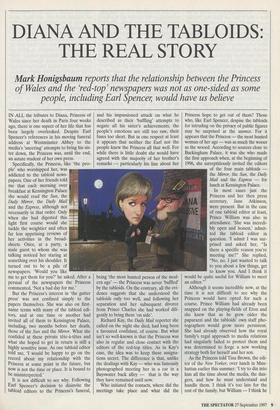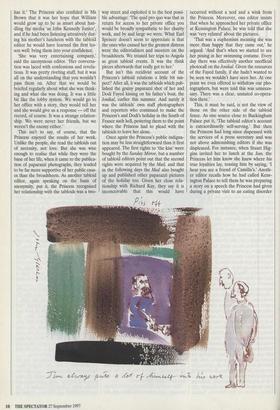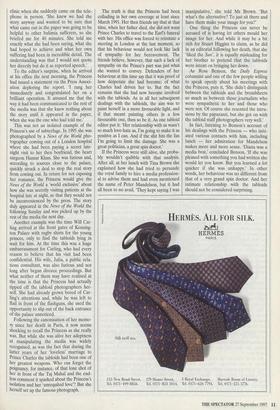DIANA AND THE TABLOIDS: THE REAL STORY
Mark Honigsbaum reports that the relationship between the Princess of Wales and the 'red-top' newspapers was not as one-sided as some people, including Earl Spencer, would have us believe IN ALL the tributes to Diana, Princess of Wales since her death in Paris four weeks ago, there is one aspect of her life that has been largely overlooked. Despite Earl Spencer's references in his moving funeral address at Westminster Abbey to the media's 'sneering' attempts to bring his sis- ter down, the Princess was, until the end, an astute student of her own press.
Specifically, the Princess, like 'the peo- ple' who worshipped her, was addicted to the tabloid news- papers. One of her friends told me that each morning over breakfast at Kensington Palace she would read the Sun, the Daily Mirror, the Daily Mail and the Express, although not necessarily in that order. Only when she had digested this light first course would she tackle the weightier and often far less appetising reviews of her activities in the broad- sheets. Once, at a party, a male guest to whom she was talking noticed her staring at something over his shoulder. It turned out to be a pile of newspapers. 'Would you like me to get them for you?' he asked. After a perusal of the newspapers the Princess commented, 'Not a bad day for me.'
But the Princess's interest in 'the gutter press' was not confined simply to the papers themselves. She was also on first- name terms with many of the tabloid edi- tors, and at one time or another had invited all of them to Kensington Palace, including, two months before her death, those of the Sun and the Mirror. What she confided at these private tete-a-tetes and what she hoped to get in return is still a highly sensitive issue. As one tabloid editor told me, 'I would be happy to go on the record about my relationship with the Princess at some point in the future, but now is not the time or place. It is bound to be misinterpreted.' It is not difficult to see why. Following Earl Spencer's decision to disinvite the tabloid editors to the Princess's funeral, and his impassioned attack on what he described as their 'baffling' attempts to negate all his sister's achievements, the people's emotions are still too raw, their fuses too short. But in one respect at least it appears that neither the Earl nor the people knew the Princess all that well. For while there is little doubt she would have agreed with the majority of her brother's remarks — particularly his line about her being 'the most hunted person of the mod- ern age' — the Princess was never 'baffled' by the tabloids. On the contrary, all the evi- dence suggests that she understood the tabloids only too well, and following her separation and her subsequent divorce from Prince Charles she had worked dili- gently to bring them 'on side'.
Richard Kay, the Daily Mail reporter she called on the night she died, had long been a favoured confidant, of course. But what isn't so well-known is that the Princess was also in regular and close contact with the editors of the red-top titles. As in Kay's case, the idea was to keep these assigna- tions secret. The difference is that, unlike the dealings with Kay — who was famously photographed meeting her in a car in a Bayswater back alley — that is the way they have remained until now.
Who initiated the contacts, where did the meetings take place and what did the Princess hope to get out of them? Those who, like Earl Spencer, despise the tabloids for intruding on the privacy of public figures may be surprised at the answer. For it appears that the Princess — the most hunted woman of her age — was as much the wooer as the wooed. According to sources close to Buckingham Palace, it was she who made the first approach when, at the beginning of 1996, she surreptitiously invited the editors of the four main tabloids the Mirror, the Sun, the Daily Mail and the Express — for lunch at Kensington Palace.
In most cases just the Princess and her then press secretary, Jane Atkinson, were present. But in the case of one tabloid editor at least, Prince William was also in attendance. 'She was incredi- bly open and honest,' admit- ted the tabloid editor in question. 'I admit I was sur- prised and asked her, "Is there a specific reason you're meeting me?" She replied, "No, no. I just wanted to talk to you about a few things, get to know you. And I think it would be quite useful for William to meet an editor."' Although it seems incredible now, at the time it is not difficult to see why the Princess would have opted for such a course. Prince William had already been snapped on the playing-fields of Eton and she knew that as he grew older the paparazzi and the tabloids' own staff pho- tographers would grow more persistent. She had already observed how the royal family's regal approach to media relations had singularly failed to protect them and was determined to forge a new working strategy both for herself and her son.
As the Princess told Tina Brown, the edi- tor of the New Yorker, over lunch in Man- hattan earlier this summer: 'I try to din into him all the time about the media, the dan- gers, and how he must understand and handle them. I think it's too late for the rest of the family, but William — rthink he has it.' The Princess also confided in Ms Brown that it was her hope that William would grow up to be as smart about han- dling the media 'as John Kennedy Junior', and if he had been listening attentively dur- ing his mother's luncheon with the tabloid editor he would have learned the first les- son well: bring them into your confidence.
`She was very entertaining company,' said the anonymous editor. 'Her conversa- tion was laced with confessions and revela- tions. It was pretty riveting stuff, but it was all on the understanding that you wouldn't pass them on. After that we would be briefed regularly about what she was think- ing and what she was doing. It was a little bit like the lobby system. We would go to her office with a story, they would tell her and she would give us a response — off the record, of course. It was a strange relation- ship. We were never her friends, but we weren't the enemy either.'
This isn't to say, of course, that the Princess enjoyed the results of her work. Unlike the people, she read the tabloids out of necessity, not love. But she was wise enough to realise that while they were the bane of her life, when it came to the publica- tion of paparazzi photographs, they tended to be far more supportive of her public caus- es than the broadsheets. As another tabloid editor, again speaking on the basis of anonymity, put it, the Princess recognised her relationship with the tabloids was a two- way street and exploited it to the best possi- ble advantage: 'The quid pro quo was that in return for access to her private office you would be broadly sympathetic to her charity work, and by and large we were. What Earl Spencer doesn't seem to appreciate is that the ones who caused her the greatest distress were the editorialisers and sneerers on the broadsheets. We treated her trips to Angola as great tabloid events. It was the think pieces afterwards that really got to her.'
But isn't this recidivist account of the Princess's tabloid relations a little bit sus- pect? After all, it was the tabloids which pub- lished the grainy paparazzi shot of her and Dodi Fayed kissing on his father's boat, the Jonikal, earlier this summer. And surely it was the tabloids' own staff photographers and reporters who continued to make the Princess's and Dodi's holiday in the South of France such hell, pestering them to the point where the Princess had to plead with the tabloids to leave her alone.
Once again the Princess's public indigna- tion may be less straightforward than it first appeared. The first rights to 'the kiss' were bought by the Sunday Mirror, but a number of tabloid editors point out that the second rights were acquired by the Mail, and that in the following days the Mail also bought up and published other paparazzi pictures of the holiday too. Given her close rela- tionship with Richard Kay, they say it is occurred without a nod and a wink from the Princess. Moreover, one editor insists that when he approached her private office at Kensington Palace, he was told that she was 'very relaxed' about the pictures.
`That was a euphemism meaning she was more than happy that they came out,' he argued. 'And that's when we started to see her posing in her swimming costume. Every day there was effectively another unofficial photocell on the Jonikal. Given the resources of the Fayed family, if she hadn't wanted to be, seen we wouldn't have seen her. At one point we even offered to withdraw our pho- tographers, but were told this was unneces- sary. There was a clear, unstated co-opera- tion there.'
This, it must be said, is not the view of those on the other side of the tabloid fence. As one source close to Buckingham Palace put it, 'The tabloid editor's account is extraordinarily self-serving.' But then the Princess had long since dispensed with the services of a press secretary and was not above admonishing editors if she was displeased. For instance, when Stuart Hig- gins invited her to lunch at the Sun, the Princess let him know she knew where his true loyalties lay, teasing him by saying, 'I hear you are a friend of Camilla's.' Anoth- er editor recalls how he had called Kens- ington Palace to tell them he was preparing a story on a speech the Princess had given during a private visit to an eating disorder clinic when she suddenly came on the tele- phone in person. 'She knew we had the story anyway and wanted to be sure that what came out in the paper was going to be helpful to other bulimia sufferers, so she briefed me for 40 minutes. She told me exactly what she had been saying, what she had hoped to achieve and what her own suffering had been in incredible detail. The understanding was that I would not quote her directly but do it as reported speech.'
To the editor's surprise, when he arrived at his office the next morning, the Princess had issued a statement via the Press Associ- ation deploring the report. 'I rang her immediately and congratulated her on a brilliant operation. It amused me that the way it had been communicated to the rest of the media was that she knew nothing about the story until it appeared in the paper, when she was the one who had told me.'
This was not an isolated example of the Princess's use of subterfuge. In 1995 she was photographed by a News of the World pho- tographer coming out of a London hospital where she had been paying a secret late- night visit to her then boyfriend, the heart surgeon Hasnat Khan. She was furious and, according to sources close to the palace, quickly struck a deal to stop the real story from coming out. In return for not exposing her romance, the Princess would give the News of the World a 'world exclusive' about how she was secretly visiting patients at the hospital late at night, so that they would not be inconvenienced by the press. The story duly appeared in the News of the World the following Sunday and was picked up by the rest of the media the next day.
Another example was the time Will Car- ling arrived at the front gates of Kensing- ton Palace with rugby shirts for the young princes, only to find the tabloids lying in wait for him. At the time this was a huge embarrassment for Carling, who had every reason to believe that his visit had been confidential. His wife, Julia, a public rela- tions consultant, was also furious and not long after began divorce proceedings. But what neither of them may have realised at the time is that the Princess had actually tipped off the tabloid photographers her- self. She had already grown bored of Car- ling's attentions and, while he was left to flail in front of the flashguns, she used the opportunity to slip out of the back entrance of the palace unnoticed.
Following the canonisation of her memo- ry since her death in Paris, it now seems shocking to recall the Princess as she really was. But while she was alive her adeptness at manipulating the media was widely recognised, as was the fact that during the latter years of her 'loveless' marriage to Prince Charles the tabloids had been one of her greatest weapons. Who can forget the poignancy, for instance, of that lone shot of her in front of the Taj Mahal and the end- less comment it sparked about the Princess's isolation and her 'unrequited love'? But she herself set up the famous photograph. The truth is that the Princess had been colluding in her own coverage at least since March 1991. Her then friends say that at that time, when her father died, she did not want Prince Charles to travel to the Earl's funeral with her. His office was forced to reinstate a meeting in London at the last moment, so that his behaviour would not look like lack of sympathy. for her bereavement. The friends believe, however, that such a lack of sympathy on the Prince's part was just what she wanted to convey. Defenders of her behaviour at this time say that it was proof of how desperate she had become; of what Charles had driven her to. But the fact remains that she had now become involved with the tabloids. As in all her subsequent dealings with the tabloids, the aim was to paint herself in a more favourable light, and if that meant painting others in a less favourable one, then so be it. As one tabloid editor put it: 'Her relationship with us wasn't so much love-hate as, I'm going to make it as positive as I can. And if the shit hits the fan I'm going to limit the damage. She was a great politician, a great spin doctor.'
If the Princess were still alive, she proba- bly wouldn't quibble with that analysis. After all, at her lunch with Tina Brown she explained how she had tried to persuade the royal family to hire a media profession- al to advise them and had even mentioned the name of Peter Mandelson, but it had all been to no avail. 'They kept saying I was manipulative,' she told Ms Brown. 'But what's the alternative? To just sit there and have them make your image for you?'
One thing the Princess can never be accused of is having let others mould her image for her. And while it may be a bit rich for Stuart Higgins to claim, as he did in an editorial following her death, that she `liked the Sun', it is equally misleading for her brother to pretend that the tabloids were intent on bringing her down.
As Ross Benson, the Daily Express columnist and one of the few people willing to speak openly about his meetings with the Princess, puts it, 'She didn't distinguish between the tabloids and the broadsheets so much as between those journalists who were sympathetic to her and those who were not. Of course she resented the intru- sions by the paparazzi, but she got on with the tabloid staff photographers very well.'
In fact, listening to Benson's account of his dealings with the Princess — who initi- ated various contacts with him, including lunch — her admiration for Mandelson makes more and more sense. 'Diana was a media brat,' concluded Benson. 'If she was pleased with something you had written she would let you know. But you learned a lot quicker if she was unhappy.' In other words, her behaviour was no different from that of a very grand spin doctor. And her intimate relationship with the tabloids should not be considered surprising.












































































 Previous page
Previous page